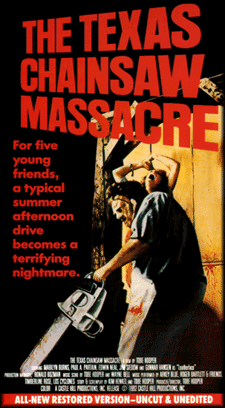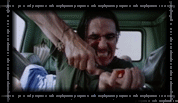


This is the
bizarre and tragically gruesome account of what happened to five young
friends one summer afternoon in rural texas. After hearing reports of grave
robbing, the group sets out to check on a family grave. Soon after, one-by-one
they wander into the murderous clutches of Leatherface.

"Families in the meat business!"
- The Hitchhiker |

Far less exploitative than its title insinuates,
The Texas Chain Saw Massacre is one of the universally recognized achievements in horror cinema, an effective and important piece of horror that has shocked and disturbed audiences since its release in 1974. And yet, there is a strong feeling of restraint and style throughout the film that successfully exploits the doctrine of “less is more”, providing fright based on the premise that won’t you don’t see is far scarier than what you do see. In essence, it achieves what horror is meant to achieve: it lets your imagination run wild.
The film centers around a group of youths, two young men and their girlfriends, plus a wheelchair bound friend, Franklin, who is the brother of one of the girls, Sally. The five are visiting the two siblings’ old house to reminisce on times past. On the way, they visit the local cemetery to check on the grave of a loved one after reports of grave robberies and vandalism, a premonition whose importance is made all too obvious in the opening sequence. Once at the house and in need of gas, two of the kids wander to a local house run entirely on gasoline generators. Not surprisingly, they are killed, and the rest of the movie becomes a search and hunt of the rest of the group by the chainsaw wielding psychopath and his family, the culprits behind the recent grave robberies.
The plot, however, is not nearly as important as how well it is played out. For all intents and purposes, the storyline is rather weak, and any character development is minimal. Instead, Hooper made the film as raw and dirty as possible in order to scare the audience due to the sheer insanity of the situation. The audience may not fully know the victims, but what they experience and are subjected to is terrifying in its own right. The best example of this, of course, is the now infamous “dinner table” scene, where there is essentially no action (besides Marilyn Burns’s screaming), but the quick cuts and camera movements exemplify the terror of the situation. This coupled with the petty torments and humiliation Sally faces (plus the fact that the family is having an everyday meal of processed human meat) reinforces the feeling of the mental rape forced upon the victim.
However, for all the insanity and “mental rape”, as I put it, that is featured,
The Texas Chain Saw Massacre is not a revealing film. The common stereotype of the film is its graphic violence; the title alone provokes thoughts of unregulated carnage and violence coupled with twisted macabre of all varieties. In reality, however, these misconceptions prove the film’s effectiveness. Although undoubtedly horrifying, the gore in the film is kept to an absolute minimum, despite innumerable opportunities for it to turn into a complete exploitation bloodbath. Almost all violence, and certainly most of the deaths, are hidden by, say, a well placed table, or even the victims’ bodies. It’s the intensity and terror of the situation that fills in the gaps, that although the audience sees little blood, the scenes are vividly remembered as explicit violence. As if borrowing from Hitchcock’s “shower scene”, what remains unseen is scarier than what is revealed.

Despite this, I believe what remains the most effective terror device in the film is not merely how well Hooper sets up the film, but the content itself. The sheer oddity to see furniture made of human bones, or a chicken in a cage hanging from the ceiling, is the creepiest aspect. To think that people live in such disarray is haunting, that the strewn collection of garbage, resembling the appearance of an abandoned house, provides the perfect location for equally heinous behavior. Hell, the only thing scarier is the non-fictional aspect; Wisconsin killer Ed Gein really did dig up corpses to decorate his house. Crime scene photos for the two murders he committed eerily resemble the house in
The Texas Chain Saw Massacre, perhaps all too well.
 |
|  |
| 
 |
| 

- Marilyn
Burns, whose character was chased by Leatherface through the undergrowth
actually cut herself on the branches quite badly, so a lot of the blood
on her body and clothes is real.
- The actor whose character was hung up on a meat hook was actually held
up by a nylon cord that went between her legs, causing a great deal of
pain.
- During the dinner scene towards the end of the film, when Leatherface cuts
the girl's finger, he actually does cut her finger because they couldn't
get the fake blood to come out of the tube behind the blade
- Director Tobe Hooper based Leatherface on mass-murderer Ed Gein,
who was arrested in 1957.
- Director Tobe Hooper claims to have got the idea for the film while standing
in the hardware section of a crowded store. While thinking of a way to
get out through the crowd, he spotted the chainsaws.
- When it was first released, the film was so horrifying that people
actually walked out on sneak previews for it.
- "Granpaw" is actually played by 18-year-old John Dugan.
- The brand name on Leatherface's chainsaw is hidden by duct tape
in order to avoid a lawsuit.
- The financing for this film came from the profits of a previous film the
production company financed - Deep Throat.
- The film was originally entitled "Headcheese", but was changed at the last
minute.
- A
family was actually living in the house that served as the Sawyer family
house in the later half of the movie. They rented out their house to the
film crew and continued to stay there during the entire shoot.
- The Human Skeleton in the house at the end of the movie was a
real human Skeleton. They used a real one because a human skeleton from
India is far cheaper then a fake plastic skeleton.




























